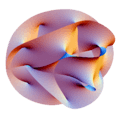Quantum gravity facts for kids
Quantum gravity is a big idea in physics that tries to explain how the universe works at both the largest and smallest scales. Right now, scientists have two main theories that describe different parts of the universe very well. One is general relativity, which explains how gravity works for huge things like planets and stars. The other is quantum mechanics, which describes the tiny world of atoms and particles. The goal of quantum gravity is to create one single theory that combines both of these ideas. It's like trying to fit two puzzle pieces from different puzzles together, which is very hard!
Contents
Quantum Gravity: Combining the Universe's Rules
What is Quantum Gravity?
Quantum gravity is a field of study that aims to merge two of the most successful theories in physics: general relativity and quantum mechanics. Imagine trying to understand how a giant elephant moves, and also how a tiny ant moves, but with one set of rules for both. That's what quantum gravity tries to do for the universe. It wants to find a way to describe gravity using the rules of quantum mechanics, which are usually only for very small things.
Understanding Gravity: Big vs. Small
To understand quantum gravity, it helps to know a bit about the two theories it wants to combine.
General Relativity: The Big Picture
General relativity was developed by Albert Einstein. It explains gravity not as a force, but as the bending of spacetime (space and time together) caused by massive objects. Think of a bowling ball placed on a stretched rubber sheet; it makes a dip. If you roll a marble nearby, it will curve towards the bowling ball. That's how general relativity explains why planets orbit stars. It works perfectly for large objects and the universe on a grand scale.
Quantum Mechanics: The Tiny World
Quantum mechanics describes the world of the very, very small, like electrons and photons. In this tiny world, things behave very strangely. Particles can be in many places at once, and their exact position or speed can't always be known precisely. It's a world of probabilities and sudden "jumps." This theory is incredibly accurate for understanding how light works, how computers operate, and how chemical reactions happen.
Why is Combining Them So Hard?
The main problem is that general relativity and quantum mechanics use very different rules. General relativity sees space and time as smooth and continuous, like a perfectly flat sheet. Quantum mechanics, however, suggests that everything, including space and time, might be made of tiny, discrete "chunks" or "quanta." When scientists try to apply quantum mechanics to gravity, their equations often break down, giving impossible answers like infinity. This shows that our current understanding is incomplete.
How Scientists Are Trying to Solve It
Physicists are working on several exciting ideas to create a theory of quantum gravity. They are looking for a "unified field theory" that would explain all the fundamental forces of nature (gravity, electromagnetism, and the strong and weak nuclear forces) as different aspects of one single force.
String Theory: Tiny Vibrating Strings
One popular idea is string theory. It suggests that the most basic building blocks of the universe are not tiny point-like particles, but incredibly small, vibrating strings. Different ways these strings vibrate create different particles, like electrons or photons. String theory also suggests there might be extra dimensions of space, curled up so small we can't see them.
Loop Quantum Gravity: Space as a Network
Another approach is called loop quantum gravity. This theory suggests that space itself is not smooth but is made up of tiny, interconnected loops, like a fabric woven from threads. These loops form a network, and the "size" of space comes from how many loops are in a certain area. In this view, space and time are "quantized," meaning they come in discrete packets, just like energy in quantum mechanics.
Why is Quantum Gravity Important?
Finding a theory of quantum gravity would be a huge step forward in physics. It could help us understand some of the biggest mysteries of the universe, such as:
- What happened at the very beginning of the universe, during the Big Bang?
- What happens inside black holes, where gravity is incredibly strong?
- What is the ultimate nature of space and time?
Solving these puzzles could give us a complete picture of how the universe works, from the smallest particles to the largest galaxies.
Images for kids
-
This is a picture of a Calabi–Yau manifold. These shapes are used in string theory to "compactify" or curl up the extra dimensions that the theory suggests exist.
See also
 In Spanish: Gravedad cuántica para niños
In Spanish: Gravedad cuántica para niños





